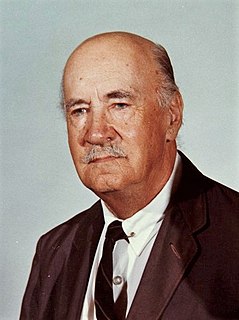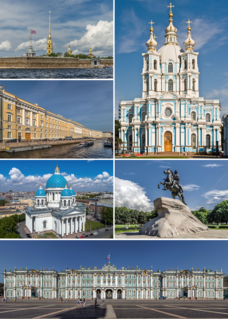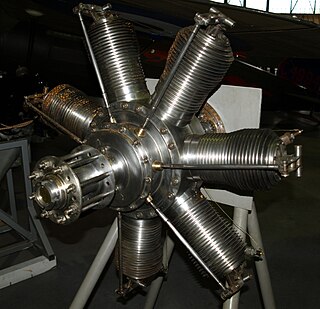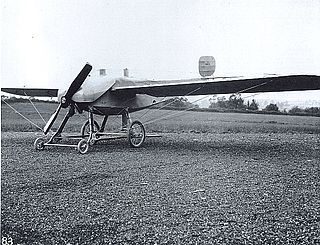
The Bristol Coanda Monoplanes were a series of monoplane trainers designed by the Romanian designer Henri Coandă for the British company British and Colonial Aeroplane Company.

The Bristol Prier monoplane was an early British aircraft produced in a number of single- and two-seat versions.

The Bristol Gordon England biplanes were a series of early British military biplane aircraft designed by Gordon England for the Bristol Aeroplane Company that first flew in 1912. Designed for easy ground transport, the aircraft could be quickly disassembled.

The Sikorsky S-16, or RBVZ S-XVI, was a Russian equi-span single-bay two-seat biplane designed by Igor Sikorsky in 1914-15. Conceived in response to demand for an escort fighter for the Ilya Muromets bombers, it was noteworthy in that it was one of the first aircraft to possess synchronisation gear for its 7.7 mm machine gun. The first S-XVI was completed on 6 February 1915 with an 80 hp engine instead of the intended 100 hp because of supply problems. On 17 December 1915, the Russian government placed an order for 18 aircraft, these being delivered in early 1916.

The Sikorsky S-20 or RBVZ S-XX was a Russian single-bay unequal span two-seat biplane designed by Igor Sikorsky in 1916. Displaying some Nieuport influence, it saw very little service during World War I.

The Sikorsky S-10 was a Russian Empiren military twin-float seaplane that served with the Baltic Fleet from the summer of 1913 to 1915. After Igor Sikorsky built the successful Sikorsky S-6 for the Russian military, he tried to build another successful aircraft for them. The S-10 was a modified S-6B built by the Russo-Baltic Carriage Factory. Approximately sixteen production versions of the S-10 were built. It had a less powerful engine and generally weaker structure than the S-6. They had either an 80 HP Gnome Monosoupape or a 100 HP Argus Motoren engine. Some were deployed on the world's first operational seaplane carriers.

The Sikorsky S-5 was an early Russian single seat biplane design by Igor Sikorsky, completed in late April 1911.
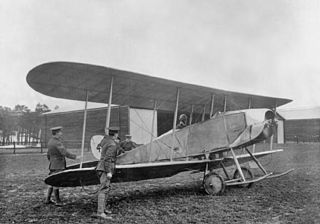
The Royal Aircraft Factory B.E.3 was a single-engined rotary engined biplane developed by the British Royal Aircraft Factory prior to the First World War. The B.E.4 and B.E.7 were virtually identical aircraft that differed only in the engine fitted.

The ASL Viking was a single-engined two seater biplane aircraft designed and built by Horatio Barber's Aeronautical Syndicate Ltd. at Hendon. It was first flown in January 1912.
The Short S.47 Triple Tractor was one of a series of experimental twin-engined aircraft built by Short Brothers in 1912. It acquired its name because the two engines drove three tractor propellers.
The Sopwith Bee was a small biplane built in 1916 as a personal aircraft for Harry Hawker, Sopwith's chief test pilot.

The Sikorsky S-7 was a Russian single engine experimental prototype aircraft built by the Russian Baltic Railroad Car Works shortly after Igor Sikorsky became chief engineer of the aircraft manufacturing division.

The Sikorsky S-1 was the first fixed wing aircraft design by Igor Sikorsky. In February 1910 work began on the pusher configured biplane powered by a 15 hp (11 kW) Anzani three-cylinder, air-cooled engine. The machine was completed in April and Sikorsky began his first attempts at flight. In early May during a take-off attempt on a windy day the machine briefly became airborne due mostly to the fact it had a favorable headwind. Further attempts were less successful and Sikorsky disassembled it, saving the main wing section to construct the S-2.

The Sikorsky S-4 was a Russian aircraft built by Igor Sikorsky using many components of the S-3 including the 40 hp (30 kW) Anzani three-cylinder engine. Construction of the biplane began in late December 1910 and was completed early in the spring of 1911. The machine was never flown but did appear in a static display at an aeronautical exhibition at Kharkov in the spring of 1911. Sometime afterward it was disassembled.

The Sikorsky S-9Kruglyj was a Russian single engine prototype aircraft completed in the spring of 1913 by the Russian Baltic Railroad Car Works while Igor Sikorsky was the chief engineer of the aircraft manufacturing division.

The Sikorsky S-11 Polukroogly was a Russian single engine prototype reconnaissance aircraft completed in July 1913 by the Russian Baltic Railroad Car Works while Igor Sikorsky was the chief engineer of the aircraft manufacturing division.

The Sikorsky S-12 was a Russian single engine trainer aircraft completed in the spring of 1913 by the Russian Baltic Railroad Car Works while Igor Sikorsky was the chief engineer of the aircraft manufacturing division.
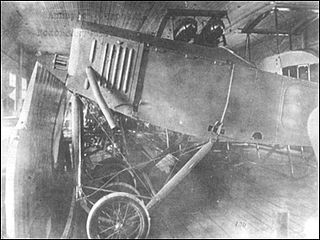
The Sikorsky S-17 was a Russian single engine aircraft built at the Russian Baltic Railroad Car Works in Petrograd while Igor Sikorsky was the chief engineer of the aircraft manufacturing division.

The Sikorsky S-18 was a Russian twin engine aircraft designed by Igor Sikorsky and built by the Russian Baltic Railroad Car Works aviation division at Petrograd during World War I.
The Farman HF.10 was a reconnaissance aircraft built in France shortly before the First World War.


